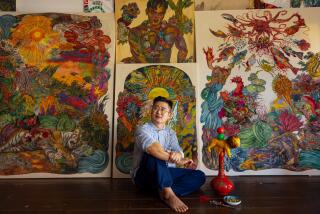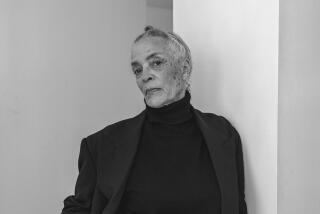Review: James Hayward’s installation delivers contemplative bliss; Faith Wilding’s ‘Imago Femina’ harmonizes feminine
A dozen James Hayward monochrome abstract paintings, most made in the last two years, create a ravishing exhibition at Roberts & Tilton gallery in Culver City. The show is capped by something that, to my knowledge, is new to the artist — an installation work.
The paintings continue the artist’s established practice of slathering thick, wide brushstrokes of single-color oil paint, usually homemade, onto flat panels covered with canvas. The support bars are deep, so that the surface stands an inch or two in front of the wall, while the exposed sides frequently reveal underpainting in one or more other hues.
The only strict horizontals and verticals that will be found are in the rectangular paintings’ edges. The brush strokes are all on an organic diagonal. Each is deliberate and pressed hard, so that ridges build up along the sides and peaks are often left at the ends, like cake frosting.
SIGN UP for the free Essential Arts & Culture newsletter >>
Sometimes the angle of the stroke is steep and sometimes shallow, and no specific pattern in their placement emerges. But structurally everything gets snapped into place. The visual result is a gestural canvas of great vigor, but one that also seems preternaturally stable.
Historically, gestural abstraction has been tied to emotional registers, with dynamic brushwork regarded as the carrier of expressionist meaning. Hayward’s intense, deliberate paintings drain all of that. Instead, the experience for a viewer is like looking at a field of grass rippled by the wind yet without a shred of illusionistic reference to nature anywhere in the painting itself.
And that’s it. One remarkable quality of these paintings is how fresh they look — remarkable because Hayward has been mining this format for more than three decades.
The structural rigor is emphasized in the gallery’s front room by the color scheme. Limited to panels of black, white and crimson, the selection builds on a legacy of Russian avant-garde art from a century ago.
The small back gallery harks back to a similar time, but it heads in the sensuous direction of Paris. Hayward has painted the room’s surrounding walls a flat, bright red, and he has installed four small paintings of different red hues. They range from a red lightened with considerable amounts of yellow to a red deepened in the direction of burgundy.
Like Matisse’s “The Dessert: Harmony in Red” (1908) or “The Red Studio” (1911), albeit without a representational image anywhere in sight, Hayward’s installation complicates the usual pictorial separations between positive and negative space, figure and ground, the moment and eternity. Chromatic saturation in varying hues delivers nothing short of contemplative bliss.
Roberts & Tilton, 5801 Washington Blvd., Culver City, (323) 549-0223, through Oct. 31. Closed Sundays and Mondays. www.robertsandtilton.com
------------
For artists, Faith Wilding has described beauty as “a terrorist tactic, rather than an end in itself.”
That’s less true today than in the recent past, when beauty was commonly seen as a suspect, trivializing indulgence. But it was certainly the case in 1978, when Wilding made a luxurious suite of gorgeous watercolors collectively titled “Imago Femina.”
Fifteen of them, each the size of a large notebook sheet, are on view at Loudhailer in precisely drawn, limpid rainbow hues sometimes set off by gold leaf. Wilding’s watercolors articulate sumptuous fictional forms with natural overtones — shapes that evoke tendrils, lungs, sex organs, calla lilies, ganglia, sea shells and more.
The Latin title nods to images of natural objects associated with femininity. Ecclesiastical language underscores this deeply secular work’s visual relationship to manuscript illuminations. Historically the province of male prerogatives, whether in Western or Eastern societies, the traditional manuscript form here gets surreptitiously, lusciously colonized.
Symmetry is a constant design motif, evident in the pervasive harmony of proportions, color and balance. The sheets become a visual meditation on the necessity — and the rewards — of taking exquisite care for the successful production of cordiality and coherence.
Beauty as intimidation in the pursuit of political ends might be a rather contrarian notion, especially when it’s rendered in such a lovely, even seductive way. But Wilding, whose work is also the subject of a current survey at the Armory Center for the Arts in Pasadena (where the Chicago-based artist lived and worked in the 1970s), makes it sing. These watercolor documents are feminist images as much as feminine ones.
Loudhailer, 2648 La Cienega Ave., Culver City, (323) 369-1594, through Oct. 24. Closed Sundays through Wednesdays. www.loudhailergallery.com
MORE:
A chilling portrait of Germany’s Weimar era emerges in ‘New Objectivity’ at LACMA
Matthew Barney’s ‘River of Fundament’? Well, it’s certainly big
An early look in the Broad museum reveals a show that doesn’t quite gel
More to Read
The biggest entertainment stories
Get our big stories about Hollywood, film, television, music, arts, culture and more right in your inbox as soon as they publish.
You may occasionally receive promotional content from the Los Angeles Times.







